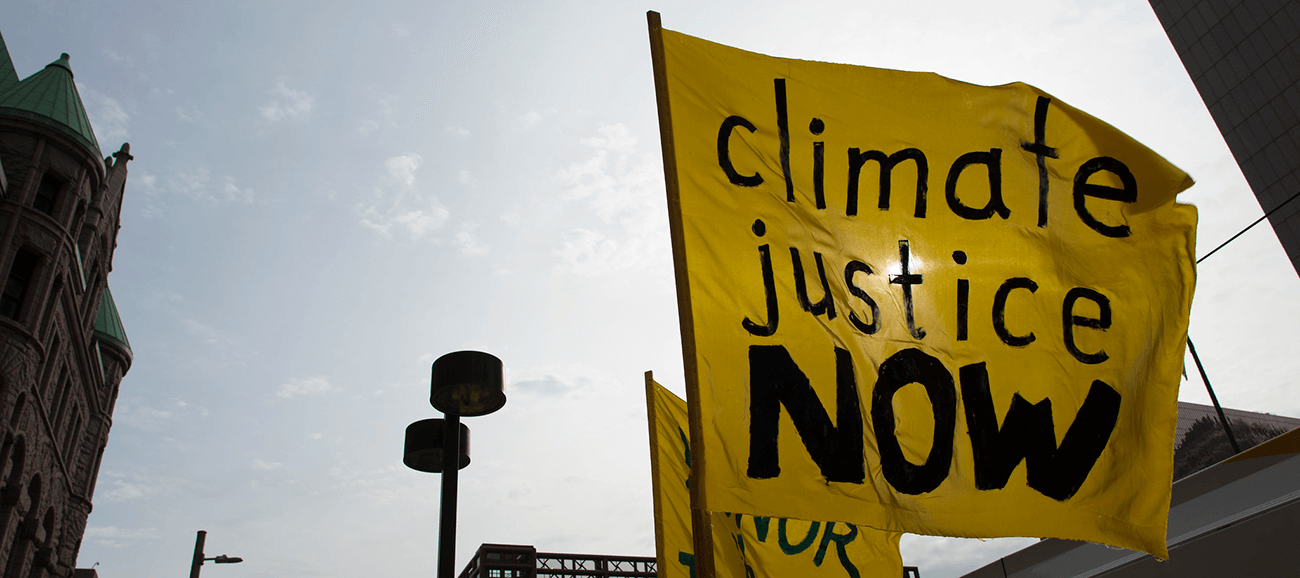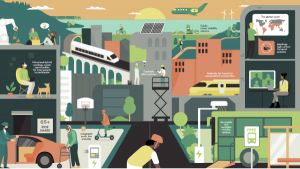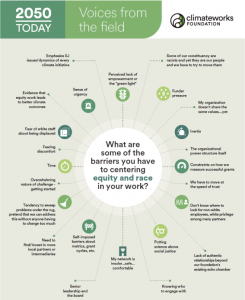
The Covid-19 pandemic and the growing global momentum in support of racial justice is profoundly redefining the course and the breadth of our discussions on how to achieve a sustainable climate by 2050, prompting us to re-examine current decarbonization pathways and strategies, and the deep social transformations necessary to address the climate crisis.
Last month, ClimateWorks Foundation hosted 2050 Today: Emerging strategies for a just, post-pandemic world as part of our 2050 Today initiative that examines new and emerging priorities that need attention today to fully decarbonize the global economy by mid-century. Over the course of three sessions, experts, grantees, and funders convened virtually to discuss the future of emissions, what a just recovery means, and what a racially and socially just agenda looks like for philanthropy.
The following themes emerged from the conversations:
The emissions implications of Covid-19 and economic recovery. Despite a significant dip in CO2 emissions in 2020 due to massive disruptions in economic and social activities worldwide, the decrease in emissions was smaller than many climate researchers had expected, given the scale of the pandemic, and emissions have picked up as economic activity has begun to recover. An assessment of 21 benchmark indicators across six key sectors measuring progress to limit global warming to 1.5° C show that the rate of change is still moving too slowly. The level of economic stimulus announced by the world’s leading economies presents a once-in-a-generation opportunity to reset the global economic trajectory with climate at the center. In February, the total amount of stimulus spending was quoted at $13.7 trillion and has since grown to $14.9 trillion. While research is showing that many governments are failing to harness the opportunity, it is not too late to build back better.
Takeaway: We must leverage an emerging set of tools to boost the economy in the short and long term, while also accelerating the transition to a more sustainable future.
The future of work and travel patterns. Covid-19 has led to some of the most dramatic reductions in everyday emissions related to flying, transportation, and urban movement patterns that we’ve ever seen. The proliferation of remote work and mistrust in centralized modes of transportation due to Covid-19 have led to significant declines in public transport ridership and aviation, and a rise in personal modes of mobility such as cars and bikes. While we see some positive trends such as the reassessment of the necessity for frequent business travel, Covid-19 has also led to troubling trends such as the exacerbation of existing disparities in transportation access. Sharp declines in public transportation ridership have exacerbated the structural racism embedded in transportation systems, given that lower income households, communities of color, and wage workers are less likely to be able to work from home and are much more reliant on public transit.
Takeaway: Collectively, session attendees imagined a better future of work and travel.
Shifting geopolitics are shaping the climate future. Multilateralism led to the successful signing of the 2015 Paris Agreement globally, but setbacks over the last four years due to Trump-led U.S. foreign policy introduced significant new stresses to the multilateral system. 2021 is a key year for framing the coming decade of international climate action. As many countries commit to net-zero emissions by 2050, action in the near-term will determine how successfully these commitments translate into concrete steps. With a strong focus on climate in the Biden administration, there is an expectation that international cooperation and multilateral alliances will once again become important and can help bolster near-term climate action.
Takeaway: It is important to understand the longer-term implications of the whipsaw in American leadership on the global order and the multilateral system. We must ensure that big power politics takes into account populism and other shifts in society (youth movement, equity issues) and responds in ways that do not create volatility in international relations.
Centering equity and justice in recovery. The Biden administration has made a commitment to allot 40% of clean energy investment to disadvantaged communities. While this is a major commitment to center climate justice in the U.S.’ sustainable recovery plans, the details are still emerging.
Takeaway: In order for Biden’s proposal to succeed, we must build the infrastructure with input and leadership from disadvantaged communities, to ensure that resources are distributed to the communities that it is intended for, in a way that does not trigger gentrification and displacement.
Just rural recovery in emerging economies. Sustainable recovery will not be possible without attention to rural places and their economies. Rural recovery is of particular importance for emerging economies and carries political salience in many developed countries. While jobs and growth dominate discussions of recovery, in rural places, sustainable and just solutions are ones that improve wealth balance. Land ownership, for example, is particularly important for rural economic recovery. In Indigenous communities, restoring peoples’ rights to their native land is justice and is essential for environmental sustainability.
Takeaway: We must understand the cultures of emerging economy countries to help address economic and social inequalities and bring sustainable recovery solutions that simultaneously solve other issues such as poverty, land tenure, and inequality.
Racial and social justice across the globe. Every country and region has its own history of racial injustice, yet there are commonalities in the negative outcomes that persist, and in the opportunities and strategies to move toward positive outcomes. Climate strategies need to center racial and social justice, and sharing clear examples of how to include marginalized communities at the decision-making table will enable philanthropic partners to build and expand on this effort.
Takeaway: For philanthropy to meaningfully integrate climate and justice goals, we must understand philanthropy’s relations to power — how it is held and shared. Session attendees were invited to reflect on the barriers to centering equity and share one commitment to racial justice in their climate work.
Closing with new insights, questions, and renewed energy
The virtual event was a space for collective dialog about the role of climate philanthropy in the upcoming years to support and catalyze just and equitable pathways for emissions reductions. We also embraced and reflected on Climate Justice Alliance’s call for ClimateWorks to do more in engaging with and learning directly from communities on the front lines of climate action.
While the discussions generated a wide range of insights, we walked away with many more questions and returned to our work with renewed energy and perspective.
Some questions that are top of mind for us and our community of climate partners:
- How can philanthropy help shape the future of work and transportation to center equity and sustainability more firmly in recovery efforts?
- How can philanthropy better work with vulnerable communities and create a strong foundation for a just recovery?
- What are effective ways for philanthropy to contribute to rebuilding power structures by stepping back and creating space for power-sharing?
We invite you to consider how these new learnings will impact your work and reach out to us with suggestions or ideas you may have as we learn and take action together.
Please note that this summary reflects discussions and data that were current as of February 2021.



